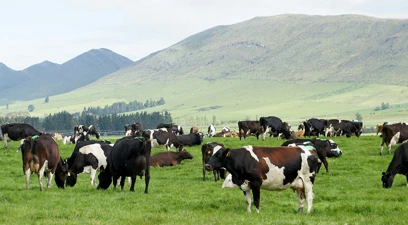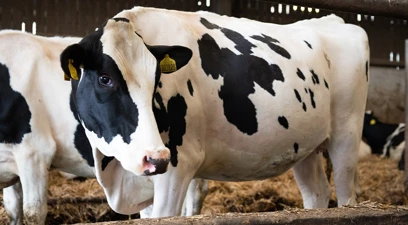Top tips for grazing turnout...
Published: 12 March 2021
Every farmer will have noticed that protein prices have surged over the past months, driving up the cost of other raw materials and resulting in more expensive compounds and blends on farm. As the most expensive component of any ration, farmers may be looking to reduce the quantity of bought-in protein this year. Grazed grass can be a rich source of readily available protein, and getting energy-dense and protein-rich spring grass into dairy cow diets can help alleviate the cost of feed.
For farmers thinking of grazing this year, the amount of land that can be allocated to grazing will principally dictate stocking rates and potential DMI per cow per day. This will also indicate the proportion of the diet that grazed grass can satisfy and dictate the need for buffer feeding, whether lower yielders are grazed full time and whether higher yielders can be grazed by day (and possibly by night).
Calculating the amount of milk that can be produced from grazed grass will allow a farmer to identify any shortfalls that can be filled by buffer feeding and parlour feeding. What is critically important is that the appropriate balance is struck between actively grazing and meeting a cow’s nutritional needs, due to the potential risk to cow health such as poor fertility and lameness if too much is expected from freshly calved cows at grass in particular.
If you are thinking of grazing this spring and summer, ideally the grazing platform should be grazed on an 18-21 day rotation to ensure optimal covers and maintain grass quality. Good quality swards with high levels of perennial rye grass allow for higher levels of milk production, compared to older swards. Farm infrastructure - especially access to temporary or permanent roadways, water troughs and water flow rates – should also be sufficient.
When cows are let out to actively graze, their indoor diet needs to be reduced in line with expected grazing intakes and adjust the PMR to complement what grass is supplying.
Once out, time at grass can be increased daily over the course of 7-10 days up to evening milking, and then full-time once grass growth rates allow.
Here are some top tips to make the best use of spring grazing…
Gradual turnout
Turning cows out to grass creates a big change in diet and imposes a stress event on the cow. It takes around three weeks for rumen microbes to adapt, so the transition to grazing must be made gradually to avoid digestive upsets and loss of performance. Aim for a few hours per day initially - cows should be able to consume 5kg DM in approximately 3 hours in suitable grass covers and weather conditions.
Dry matter intakes
The moisture content of grass can vary significantly in spring, and this can have a major impact on DMI. At 15% DM a cow estimated to consume 15kg of grass dry matter needs to eat 100kg of fresh grass! It is important that you don’t overestimate potential DMI from grazing, or body condition score, performance and fertility will be compromised.
Excess crude protein
Lush, leafy spring grass can often have CP in excess of 250g/kg DM, particularly after fertiliser application, which is mainly rumen degradable protein (RDP). Rumen microbes are unable to utilise this much protein particularly if there is a shortage of fermentable energy available to them. Excess RDP is broken down into ammonia in the rumen, absorbed into the blood stream and converted to urea in the liver. Elevated blood urea nitrogen (BUN) levels from excessive CP can increase body condition score loss, reduce fertility and impact on hoof health.
Buffer feeding
During the gradual transition to grazing, supplement cows with forages with a high energy content and digestibility to maximise DMI and performance. High DMD grass silage (>28% DM) and starch-based forages like maize silage enhance nitrogen use in the rumen and increase microbial protein synthesis due to the added fermentable energy. This will help to maintain milk constituents and protein, in particular, as well as ensuring sufficient dry matter intake, which is critical in early lactation.
For higher yielding herds that are going partial grazing and may require a night time or mid day feed these forages will compliment grass well and formulated blends, brewery, distillery and bakery / confectionary by-products can all also play an effective role.
Highly digestible grass swards can challenge rumen function
Lush spring grass with a high proportion of leaf to stem, will lower structural fibre levels in the diet. This lack of ‘scratch factor’ impacts on cudding rates and saliva production, compromising rumen function. While the nutrient analysis of grass can vary wildly, can also be accompanied by high sugar levels – often more than 18% during sunny, dry weather. High sugar levels are great for rumen fermentation, good milk proteins and strong yield. However, low structural fibre accompanied by high sugar levels can further challenge rumen function, leading to acute or sub-acute rumen acidosis (SARA).
Consequently, milk solids can be compromised as a result, whilst prolonged challenges can impact fertility. However, high levels of unsaturated fatty acids in spring grass can also cause butterfat % to be reduced, so lower butterfat doesn’t always mean SARA is a problem.
Compound feeding
Compound feed fed through the parlour should provide the DM that grass and forages do not supply to meet energy requirements for a given yield. Nutrient content of the compound feed must also balance that of the grass to optimise rumen fermentation and maximise performance; this is particularly important when cows are not given buffer feed or a midday feed. Aim for a feed with around 14-16% CP, high digestible fibre content (sugar beet pulp and soya hulls), a balanced source of cereals including maize and barley and a source of bypass protein. It should also contain minerals that grass is deficient in, for example magnesium.
Monitor what the cows are telling you
Assess rumen fill 2-3 hours after milking to determine whether adequate grass has been allocated; monitor cudding rate – you are looking for more than 65% of the herd to be lying down chewing the cud 2-3 hours after milking; check dung consistency – loose, bubbly dung with undigested fibre in it is indicative of poor rumen function, as is the presence of cud balls in collecting yards or cubicles; monitor condition – cows losing excessive body condition can point to insufficient feed intake, a possible metabolic disorder, health issue or sub-optimal rumen function.
Milk quality
Monitor bulk tank milk collections for average yields and constituents. A fall in butterfat or protein of 0.3% or greater in one week is a warning sign for poor rumen function and SARA. It is also useful to keep an eye on the butterfat to protein ratio to ensure this falls within the optimum range of circa 1.2:1.
Feed Actisaf® live yeast
Adding Actisaf® live yeast to your cows’ ration will reduce setbacks in performance at turnout by helping the rumen bugs adjust to grazed grass faster and more effectively, thereby improving rumen function. Actisaf® also reduces the risk of SARA, both at turnout and throughout the grazing period.
Actisaf® helps to stabilise rumen function and promotes milk solids and milk yield. Actisaf® is the only live yeast on the market that has consistently been demonstrated to stimulate the exact microbes identified by international research to be positively correlated with higher feed efficiency in dairy cattle.
By supporting these and other rumen bugs, Actisaf® helps cows produce more milk from forage and reduces setbacks in performance at turnout by helping the rumen microbes adjust to grazed grass more quickly and effectively. It also helps maintain milk yield persistency for cows at grass, and limits sudden drop-offs in yield post-peak, supporting a more persistent lactation curve. It should be included at a recommended rate of 1kg/tonne of grazing compound, assuming a feed rate of 4-8kg compound/cow/day.
Related Tech Info

As dairies across the UK and Ireland look ahead to winter feeding, there is much to be considered. With high feed costs and l...

As the year progresses and grass matures, palatability and digestibility reduce, meaning intakes and milk yield can drop off....

With calving season in full swing, the prospect of a more sustainable milk price in 2024 and the end of a long housing period...
